Carbon dioxide (CO2) is the most abundant greenhouse gas produced by human activities, mainly through the combustion of fossil fuels. Ice core records have revealed the variability of atmospheric carbon dioxide on multiple time scales. Examination of ice cores records and comparisons with recent instrumental records (i.e. Mauna Loa Station) show that present CO2 concentrations are much higher than any period for the last several hundred thousand to a million years. Large natural CO2 fluctuations occurred between glacial (G) and inter-glacial (IG) periods ranging generally between ~180 – 280 parts per million (ppm). Human impacts on CO2 is marked by a dramatic rise in concentrations around the mid-1700s coinciding with the onset of the Industrial Revolution. CO2 concentrations have continued to rise to present at increasing rates reflecting industrial/agricultural expansion and population growth.








Ice Cores: Greenhouse Gases (GHGs)
Greenhouse gases (GHGs) are gases in the atmosphere that absorb and emit thermal radiation (heat). The primary GHGs in the Earth's atmosphere are water vapor, carbon dioxide, methane, nitrous oxide, and ozone. GHGs allow solar radiation to reach and warm the Earth’s surface, which then reradiates long-wave radiation (heat) into the atmosphere. GHGs can absorb this long-wave radiation, trapping the heat in the lower atmosphere. Higher concentrations in the atmosphere of GHGs allow greater “trapping” of thermal radiation. Human emissions of GHGs since the Industrial Revolution has greatly increased GHG concentrations in the atmosphere. Ice core records reveal past concentrations of GHGs and clearly show the impact of human emissions.
Carbon dioxide (CO )
2
Methane (CH )
4
Nitrous oxide (N O)
2
Methane is a strong GHG produced both naturally and through human activities. Wetlands are thought to be primary natural source of methane. Anthropogenic sources include oil, coal, and gas extraction, waste treatment, landfills, agriculture, and biomass burning. Ice core records reveal that concentrations of atmospheric methane have more than doubled since the pre-industrial period.





Nitrous oxide is produced by both natural and anthropogenic sources. Natural sources are mainly microbial action in soils and water. Human sources are agriculture, sewage treatment, and combustion of fossil fuel. Ice core records demonstrate that recent N2O trends are similar to global agricultural expansion during the past few centuries.








